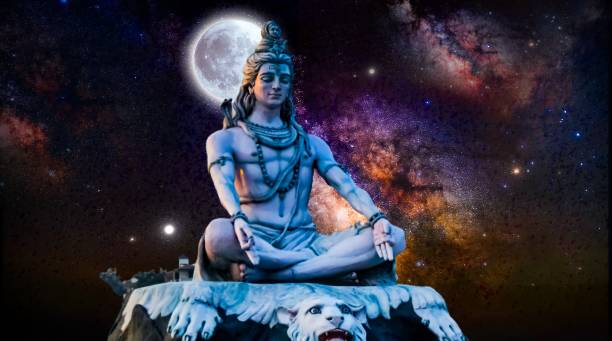The “Vairagya Shatakam” is a famous Sanskrit poem attributed to Bhartrhari, who lived in ancient India, possibly around the 5th century CE. Apart from being a great King, he was also a renowned philosopher, a great poet, scholar, and Vedantin, a truly versatile genius.
Bhartrhari has written many works in Sanskrit, out of which his Shringara Shatakam, Niti Shatakam, and Vairagya Shatakam are the most popular.

Shatakam means a work consisting of 100 verses. He has written these three Satakams to reveal the four Purusharthas, the human goals (Kama, Artha, Dharma, Moksha), which are accepted in our tradition.
Shringara Shatakam deals with Kama Purushartha, Niti Shatakam deals with Artha and Dharma, and Vairagya Shatakam deals with the qualifications required for Moksha.
Vairagya Shatakam Classification
The “Vairagya Shatakam” consists of 100 verses that explore the concept of Vairagya, which means detachment or renunciation that is required as a qualification for Moksha Purushartha.
The poem encourages readers to seek detachment from the transient and material aspects of life and to discover the eternal and unchanging essence within.
The topics covered in these 100 verses are broadly classified as,

- Samsara Doṣa Darsanam – seeing the disadvantages of worldly pursuits.
- Mohaha – the delusion of the human being which makes them incapable of seeing the worldly disadvantages. It blinds them.
- Vairagya Stuti – the greatness of Vairagyam, dispassion or detachment
- Upadeshaha – Bhartr̥hari’s advice/instructions to humanity on giving importance to Moksha. He advises seekers to start early when their bodies and minds are still healthy
In order to make it easier to read and comprehend, these 100 verses are further grouped into 10 divisions, each dealing with various aspects of vairagya, as classified above.
Mundane Desires (Verses 1-10)
In these verses, Bhartṛhari highlights the futility of worldly desires. He explains that desires for material possessions and sensual pleasures are insatiable and lead to suffering.


Bhartrhari emphasizes the transitory nature of life, highlighting that youth, beauty, wealth, and relationships are all fleeting.
He encourages individuals to detach from the material world and seek spiritual wisdom, ultimately advocating for the pursuit of a deeper, lasting truth and inner contentment.
These verses serve as a foundation for the larger work, promoting the concept of Vairagya, or renunciation, as a path to spiritual realization and liberation from the cycle of birth and death.
The essence is that the pursuit of material wealth and pleasures is endless and ultimately unfulfilling.
The Impermanence of The World (Verses 11-20)
Bhartṛhari highlights the fleeting and constantly changing character of the world. He describes it as a “dream” or “illusion” (Maya), emphasizing that all aspects of this material world are susceptible to alteration, deterioration, and destruction. This serves as a wake-up call, urging individuals to look beyond temporary pleasures and possessions.
In verses 21-30 of Bhartrhari’s Vairagya Shatakam, the focus remains on the theme of detachment and the impermanence of the world. Bhartrhari elaborates on the idea that the material world is fleeting and filled with uncertainties.
He highlights that people often chase after desires and material possessions, only to be met with disappointment and suffering. The verses encourage individuals to recognize the transitory nature of life and develop a sense of dispassion towards the ever-changing world.
By cultivating a sense of detachment, one can attain inner peace and contentment, which is far more enduring and fulfilling than the pursuit of worldly desires. These verses continue to emphasize the concept of vairagya, or renunciation, as a means to attain spiritual enlightenment and liberation from the cycle of worldly suffering.
The core essence of these verses is that everything in the material world is temporary, and one should not become attached to it.
Criticism of A Supplicant Mentality Towards Poverty (Verses 21 – 30)
Verses 21-30 of the “Vairagya Shatakam” condemn the supplicant attitude that often accompanies poverty. They underscore the importance of maintaining one’s dignity, self-respect, and spiritual aspirations even in the face of challenging material conditions.


Bhartrihari criticizes the mindset of supplication or begging that often comes with poverty. He suggests that a supplicant attitude is demeaning and disempowering, as it forces individuals to depend on others for their basic needs. The act of begging or constantly seeking help can erode one’s sense of worth and pride.
Experiencing poverty and relying on supplication can generate feelings of inadequacy and guilt when individuals struggle to meet their obligations to their families and society. This emotional burden can further hinder their personal growth and well-being.
Instead if one accepts the creator-created Meru, representing the inconceivable wealth, the naturally available fruits and roots as food, the sky be our clothing, earth be our bed, then there is absolutely nothing to acquire, everything that we seek is already ours, and has been ours to begin with.
However, yogis characterize begging for food as a means to dissolve negative qualities such as wicked pride, egotism, and impatience.
They believe it eliminates the various evils of worldly existence, is effortlessly accessible at any place and time, holds significance for holy individuals, and serves as a form of self-purification.
The Transience of Youth’s Enjoyment (Verses 31 – 40)
Bhartṛhari reflects on the fleeting nature of youth and beauty. He suggests that attaching one’s self-worth to physical appearance is futile.
In verses 31 – 40 of Bhartrhari’s Vairagya Shatakam, the focus shifts towards self-reflection and the impermanence of the human body. Bhartrhari explores the notion that the physical body is temporary and subject to decay, highlighting the inevitability of old age, illness, and death.

He emphasizes the temporary aspect of physical beauty and the constraints of the senses. The verses stress the importance of realizing that the body is merely a temporary abode for the soul, and one should not become overly attached to it or be swayed by bodily pleasures and discomforts.
By recognizing the transient nature of the physical self, individuals can cultivate a sense of detachment from their own bodies, thereby directing their focus toward spiritual growth and liberation from the cycle of birth and death.
These verses serve as a reminder of the impermanence of the physical form (youth and beauty) and the need for spiritual realization beyond the material world.
Description Of The Nature Of Time – Verses 41-50
Verses 41-50 of Bhartrihari’s “Vairagya Shatakam” provide a description of the workings of time and offer profound insights into the transient and ever-changing nature of the world.
Bhartrhari highlights the ephemerality of existence and the constant progression of time. He describes the fleeting nature of youth, beauty, and the various stages of life. This impermanence is a central theme in many spiritual and philosophical traditions and serves as a reminder of the transient nature of all things.
The verses emphasize that everything in the world is subject to change and transformation due to the relentless march of time. Even the most solid and secure aspects of life can be swept away by the passage of time.
Understanding the nature of time can help individuals detach from the transient and ephemeral aspects of life. By recognizing the impermanence of all things, people can free themselves from excessive attachment and find a more balanced and peaceful state of mind.
When individuals understand the impermanence of the material world, they are more likely to seek deeper, lasting truths and spiritual wisdom.

Bhartrhari encourages individuals to embrace the changes brought by time with equanimity and acceptance, rather than resisting or lamenting them. Embracing the fleeting quality of life can result in increased contentment and tranquility.
He further suggests that there is an eternal witness within us that remains constant amidst the changing tides of time. This eternal aspect of our being is beyond the reach of time and change and is often associated with the spiritual self or the atman.
Contrast Between A Monarch & An Ascetic – The Futility of Riches – Verses 51 – 60
Verses 51-60 of Bhartrhari ‘s “Vairagya Shatakam” draw a comparison between a king and an ascetic (renunciant) to explore the contrasting ways in which they live and the different paths they follow.
Bhartrhari contrasts the extravagant and opulent lifestyle of a king with the simple and austere life of an ascetic.
The king is often depicted as living in luxury and surrounded by wealth and material pleasures, while the ascetic leads a life of renunciation, free from worldly possessions and desires, focusing on inner richness and self-realization.


The king indulges in pleasures and responsibilities associated with his royal duties, while the ascetic embraces solitude and engages in meditation and contemplation.
The verses reflect on the transient nature of life and the inevitable end that both the king and the ascetic will face. They remind us that regardless of their paths, all individuals must confront mortality.
The comparison underscores the idea that individuals have a choice in how they live their lives. The king’s path is marked by external success and worldly achievements, but it can also lead to entanglement and suffering. The ascetic’s path, on the other hand, may involve hardships but can lead to inner peace and spiritual realization.
Ultimately, the verses suggest that inner fulfillment and liberation are more enduring and valuable than external achievements.
While the king may enjoy material abundance, the ascetic’s path is directed toward the liberation of the soul. The verses serve as a reminder of the potential for both external and internal growth regardless of the different paths that individuals can choose to follow in their lives.
The Nature of The Mind – Control of Mind & Simulating Wisdom- Verses 61-70
In verses 61-70 of Bhartrhari’s Vairagya Shatakam, the focus shifts towards the exploration of the human mind and the challenges it presents in the pursuit of detachment and inner peace.
These verses focus on the restless and unsteady nature of the human mind, which constantly oscillates between desires and aversions. Bhartṛhari suggests that true renunciation begins with mastery over the mind and controlling the mind is crucial for achieving detachment.

He emphasizes the need to tame and control the mind, as it often leads individuals into the snares of materialism and attachment.
Bhartrhari suggests that true detachment can be achieved by cultivating a sense of equanimity, maintaining balance in the face of life’s dualities, and transcending the mind’s whims and fancies.
The verses highlight how the mind is often the source of suffering. It clings to past regrets and future anxieties, leading to inner turmoil. However, it also has the potential to free individuals from suffering through self-awareness and mindfulness.
These verses underscore the importance of mental discipline and self-mastery as essential components of the journey towards spiritual liberation.
The text also distinguishes between the mind and the true self (atman). While the mind is restless and changeable, the self is unchanging and eternal. Recognizing this distinction is crucial for achieving spiritual liberation.
In essence, verses 61-70 of the “Vairagya Shatakam” explore the complex nature of the mind and its role in human experiences. The verses also project the importance of distinguishing the mind from the true self and recognizing the mind’s influence on one’s perception of reality.
Distinguishing The Unchanging Reality From The Mutable – (Verses 71-80)
In verses 71-80 of Bhartrhari ‘s “Vairagya Shatakam,” the focus is on discriminating between the immutable reality (the unchanging, eternal truth) and the mutable (changing, impermanent) aspects of existence.
Bhartrhari encourages individuals to discern between that which is temporary and subject to change (the mutable) and that which is eternal and unchanging (the immutable). This discrimination is essential for spiritual understanding and liberation.


The verses emphasize the impermanence of the material world and everything within it. External entities, relationships, and experiences are prone to changes, deterioration, and eventual dissolution. Recognizing this impermanence is crucial for cultivating detachment.
The verses explore the illusory nature of the material world. The mutable aspects of existence can create a veil of illusion, making it challenging for individuals to perceive the unchanging reality beyond the transient appearances.
Bhartrhari refers to the self as the eternal witness that observes the changing phenomena without being affected by them. This witness consciousness is beyond the fluctuations of the mind and the changing scenes of life.
Discrimination between the mutable and immutable is seen as a path to spiritual awakening. By acknowledging the transience of the external world and harmonizing with the enduring reality within, individuals can achieve an elevated state of consciousness and liberation.
This renunciation is not a rejection of the world but a release from the bonds of attachment that lead to suffering.
In essence, verses 71-80 of the “Vairagya Shatakam” guide individuals in discriminating between the transient nature of the material world and the eternal reality within themselves.
This discrimination is a fundamental aspect of spiritual practice, leading to detachment, self-realization, and liberation.
The verses encourage individuals to shift their identification from the changing aspects of existence to the unchanging essence of the self, fostering a deep understanding of the immutable reality that transcends the ever-changing world.
Worship of Lord Shiva (Verses 81-90)
In these verses of Vairagya Shatakam, Bhartrhari expresses deep devotion to Lord Shiva, emphasizing the unity between Shiva, the Lord of the universe, and the inmost Self of the universe, represented as Vishnu.
Despite recognizing the inherent oneness, the devotion is specifically directed towards the form of Shiva adorned with the crescent moon on his crest.

The verses vividly describe the individual’s longing for spiritual ecstasy, seeking refuge in Shiva to escape the cycle of birth and death.
The imagery paints scenes of peaceful meditation on the banks of heavenly rivers and nights spent in the holy forest. The spiritual seeker yearns for a life devoted to Shiva, giving up material possessions, and finding solace in the contemplation of Hara’s (Shiva’s) feet.
The verses further express a desire for a simple, ascetic life, bathing in the sacred waters of the Ganga, living in solitude, free from desires, and rooted in self-realization.
The ultimate aspiration is to attain moksha, the liberation from the cycle of life and death, through the grace of Lord Shiva.
The poet envisions a state of bliss where even before leaving the body, yogis experience uninterrupted Supreme Bliss, making the path to moksha accessible through Shiva’s grace.
The Supreme Renunciation (Verses 91-100)
In Verses 91 to 100, the final verses of Vairagya Shatakam, Bhartrhari explores the highest form of renunciation, which is renouncing the ego and merging with the Divine. This is the ultimate goal of spiritual practice.

He specifically concentrates on the actions and living ways of a self-realized ascetic, highlighting the characteristics and behaviors of someone who has attained a profound level of detachment and spiritual realization, having found a deep sense of contentment and peace within themselves.
The ascetic is not swayed by material wealth or possessions. They view them as transient and do not form attachments to them. They have transcended desires, understanding their ephemeral nature. They don’t seek fulfillment in external desires and have found contentment within.
They maintain a sense of balance and equanimity in all circumstances, whether pleasant or challenging. This doesn’t imply absolute isolation, but rather a mental disengagement from the dramas of the world. They may engage in the world but are not affected by its ups and downs.
The ascetic is committed to self-realization, seeking truth, and finding inner peace through spiritual practices. Despite their detachment, they might engage in selfless service and show compassion towards others, but without being entangled in emotional attachments.
In Essence, Bhartrhari’s verses articulate the state of mind and the actions of an ascetic who has transcended the pull of worldly distractions and achieved a higher state of consciousness.
It’s not just about renouncing physical possessions but about a mental and spiritual state of being that allows one to live in the world while being detached from its nature.
Conclusion
The 100 Verses of “Vairagya Shatakam” is a profound philosophical work that encourages individuals to detach from the transient world and seek inner peace and spiritual realization. Every set of verses offers valuable perspectives on the essence of existence and the journey toward liberation.
Bhartrhari, in addition to being a monarch, distinguished himself as a scholar, talented poet, philosopher, thinker, and an all-round religious individual. He articulated these sentiments through poetry, drawing inspiration from diverse life experiences.
Technically speaking the art of Bhartrhari ’s poetry is inexplicable. The distinctiveness of style, the depth of emotions, the arrangement of words, and these sublime elements collectively defy comprehensive capture through any amount of discursive writing.
These teachings are designed to guide individuals on the path of self-realization and detachment, emphasizing the importance of inner peace and contentment over external desires and attachments.
- The Namagiri Thayar Mantra – For Wisdom, Creativity & Prosperity - April 29, 2024
- Krishnashtakam – “Krishnam Vande Jagadgurum” – Lyrics & Meaning - April 4, 2024
- Karadarshanam – “Karagre Vasate Lakshmi” – Meaning & Benefits - March 26, 2024

0 Comments